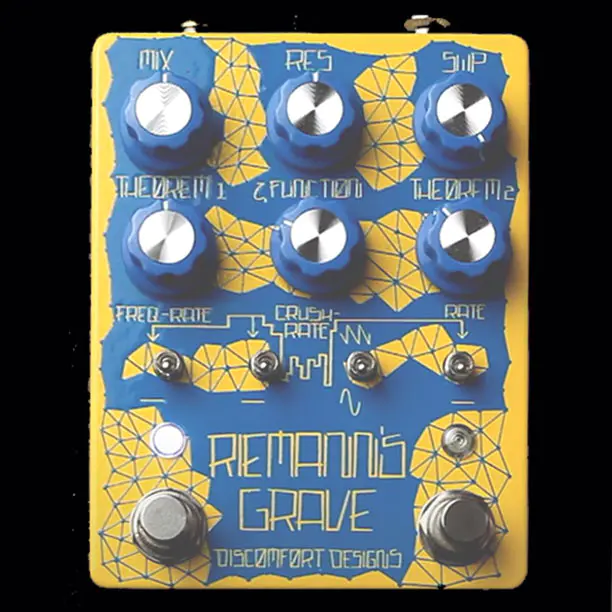
The Discomfort Designs Riemann’s Grave is not a simple distortion pedal; it’s a powerful, self-contained workstation for timbral sculpting, combining multimode distortion, a state-variable filter, and deep random modulation in a single compact unit.
The pedal operates as a dual-engine system. On the right, the “Zeta Function” section acts as a harmonic mulcher. Its three-way switch selects between waveshaping, bitcrushing, and octave distortion, with a control knob to dial in the intensity of the sonic degradation.
This mangled signal is then fed into the left-side state-variable Filter, which you can sculpt with Frequency and Resonance controls. A three-way switch toggles between Band Pass, Low Pass, and High Pass modes, giving you precise control over the final tonal character.
Where the Riemann’s Grave truly transcends is in its onboard modulation. A central switch routes either static, random, or a wandering sine wave to modulate the filter’s frequency, creating dynamic, evolving movement. Furthermore, a dedicated “Jitter” knob applies chaotic, random modulation to all other parameters simultaneously, causing the distortion and filter to interact in frenetic, unpredictable, and captivating ways.
With independent footswitches for the distortion and filter sections, a clean Mix control, and adjustable modulation Depth, the Riemann’s Grave is less of a traditional stompbox and more of an integral instrument for experimental sound design and generative texturing.
—
Discomfort Designs Riemann’s Grave V1

Discomfort Designs Riemann’s Grave V1, Builder’s Notes
What have we got here? Riemann’s Grave is a curated trio of biquad filters paired with a sample rate reducer. So you can filter your freqs and crush your bits in some very unique, interesting, and uncomfortable ways. It’s also named for a dead mathematician.
Features:
Mix: This knob controls the wet/dry mix. By law, there has to be a mix knob. Without a mix knob, we all go to jail.Resonance: (RES) This is a universal parameter that adds emphasis to the cutoff frequency of all three filters. High levels of resonance will get extreme results! One way to use resonance is with a fixed filter to really push a specific frequency range. Another way is to use with a modulated filter to get flubbly-whubbly sounds. There are probably other uses, but no one knows about them anymore.
Sweep Filter: (SWP) This bounceable LPF is controlled by the footswitch on the right. Pressing the foot switch will momentarily close the filter (set the cut off frequency to zero) and it will gradually return to an open position, according to the setting of the sweep knob. Turn CW for slower and longer sweeps.
Theorem 1: The first filter, a resonant 24 dB per octave low pass filter. With toggle 1 pointing down, the cutoff frequency is fixed. Turn CW to close the filter, CCW to open. With toggle 1 pointing up, random modulation is applied to the cutoff frequency. Turning CW now controls how rapidly an new cutoff frequency is selected.
Zeta Function: This controls the sample rate reduction/bit crushing. Higher settings will mangle and crush, and create some wonderfully ugly atonal messy sounds. Drums love that kind of thing. In fixed mode (Toggle 2 down) the knob controls the amount of reduction, turn CW for lower sample rates. In random mode (Toggle 2 pointing up) the knob controls how often a new rate of crushing is selected.
Theorem 2: The second filter, also a resonant LPF. The cutoff frequency of this filter is modulated either by a curvy (sine wave) or pointy (ramp wave) shaped LFO. The speed of LFO is controlled by the rate knob. Toggle 3 will select the LFO wave shape. Toggle 4 will choose a constant (down) or random (up) modulated LFO.






















